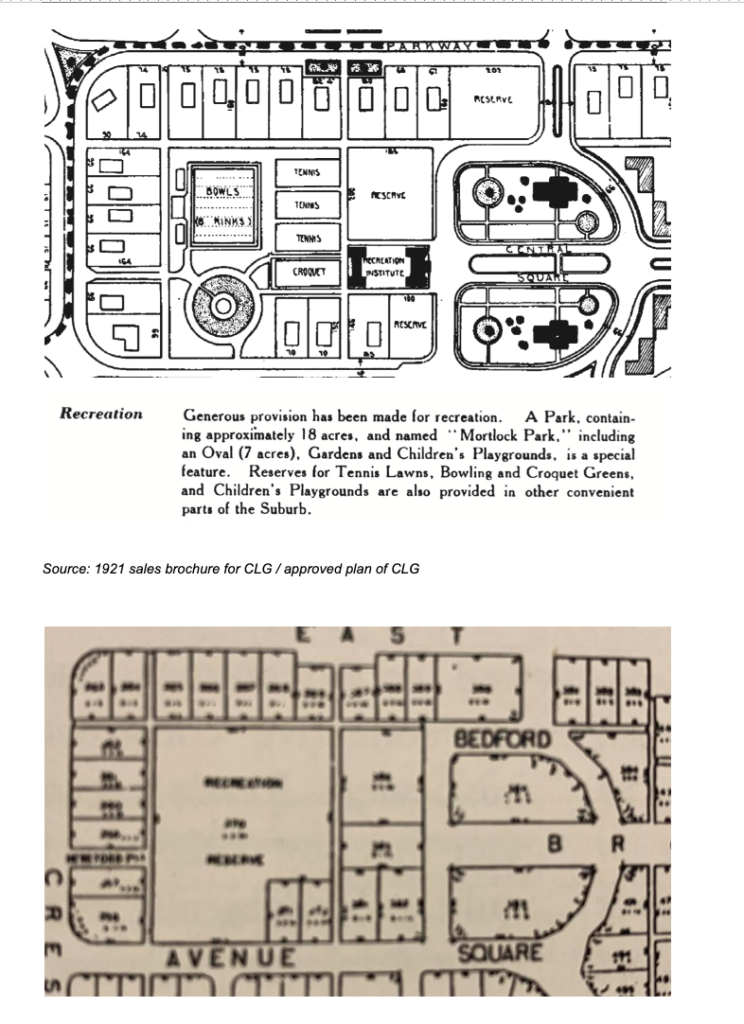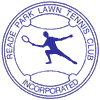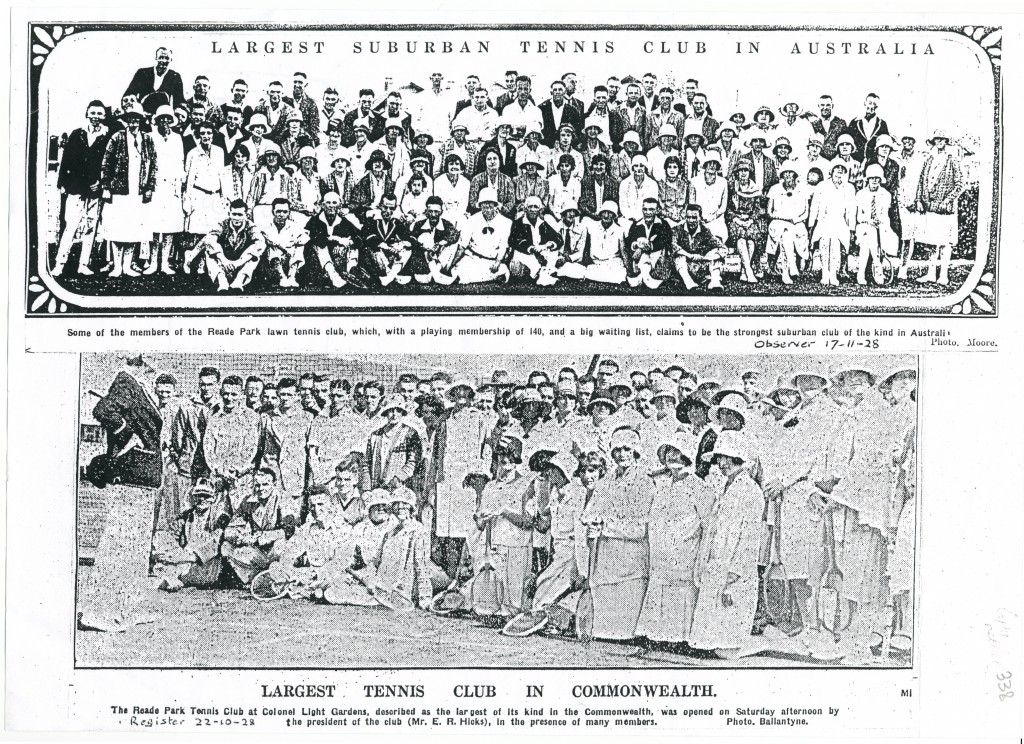The northern recreation space that is now known as Reade Park was designated in the original CLG plan to provide for active and passive pursuits with tennis, croquet and lawn bowls specifically documented by the garden suburbs principal planner Charles Reade. We are proud to perpetuate his name to this day.
The State Heritage area of Colonel Light Gardens (CLG) was built upon land purchased by the State Government in 1915 from the trustees of the William Mortlock estate with the intention to establish a model garden suburb as advocated by planner Charles Reade. With
this goal in mind, the State Government employed Charles Reade as South Australia’s first Town Planner in order to prepare plans for a model suburb which were titled “Mitcham Garden Suburb.” The implantation of these plans was ultimately put on hold as a result of
World War I and in 1919 the Garden Suburb Act was passed which included a detailed plan for the suburb’s development and in 1921 the “Mitcham Garden Suburb” became what is now Colonel Light Gardens.”
Colonel Light Gardens developed from the mid-1920s and by the late-1920s was almost complete. Originally responsibility for decision making in CLG vested in the State and the Garden Suburb Commissioner, in 1975 this responsibility was transferred to the City of
Mitcham and Council has been responsible for all decision making and maintenance of CLG since.
Although Reade’s plan was never fully realised due to alterations made by Walter Scott Griffiths to accommodate low income housing as part of the Thousand Homes Scheme, CLG is still considered “Australia’s best example of a garden suburb. The recognition of
CLG as an important representation of a garden suburb was formalised when in May 2000 the Development Plan was authorised creating The State Heritage Area of Colonel Light Gardens followed by the suburbs placement upon the State Heritage Register (SHR). This
followed its placement on the Register of the National Estate (RNE) on 26th October 1999.
According to the South Australian Heritage Register CLG is of heritage value for the following reasons:
• It exemplifies the theories of town planning of the early 20th century based on the Garden City concept, and is considered the most complete and representative example of a Garden Suburb in Australia, combining both town planning, aesthetic
and social elements into coherent plan. The public and private spaces of the suburb meld to create a distinctive three-dimensional suburban design.
• It represents the best work of Charles C. Reade, who was the first appointed Town Planner in Australia and South Australian Government Planner from 1916–20. Reade was the leading exponent of the Garden City Movement to practise in
Australia.
• It is the repository of the majority of houses built under the mass housing programme of the Labor Government of the 1920s known as the Thousand Homes Scheme and became the area identified with the scheme. International visitors were taken to view
the housing developments at Colonel Light Gardens during the 1920s. It contains a homogeneous style of residential architecture representing the particular workingman’s house idiom of the mid-1920s, developed from the Californian
Bungalow design.
• It is the embodiment of other, more ephemeral social concepts of the 1920s such as ‘post-war reconstruction,’ ‘homes for returned soldiers’ and ‘community spirit and self-help’ which led to the creation and development of a community.’
(as entered on the South Australian Heritage Register, 4 May 2000) Council has a legal obligation under the Heritage Places Act 1993 to conserve and manage Colonel Light Gardens in line with the values outlined in the Statement of Cultural
Significance, stated above.
Historically, the planning of Colonel Light Gardens follows the appointment of Charles Reade as South Australian Government Town Planner in 1916. Reade was a proponent of the Garden City movement which originated in the UK. Key dates relevant to Colonel Light
Gardens include:
1916 – Charles Reade employed as Australia’s first Government Town Planner
1917 – Reade to prepare plans for Mitcham Garden Suburb
1919 – Garden Suburb Act passed
1921 – Mitcham Garden Suburb named ‘Colonel Light Gardens’ and first land sales commence.
1924 – ‘Thousand Homes Scheme’ initiated resulting in redesign of Reade’s original plan
1940’s – Piccadilly Circus and unused shop sites allocated for housing
2000 – CLG included on Register of National Estate and listed as State Heritage Area
2021 – Heritage Standards for Development (Colonel Light Gardens State Heritage Area) adopted
2022 – Public Realm Heritage Guidelines (PRHG) Council policy document adopted
The layout of the precinct today is the same as it was in the (subsequent) 1925 ‘Thousand Homes Scheme’ plan where the entire space was dedicated to the 3 sports in response to public need.

Reade Park, was the site of a small clubhouse erected for tennis players by June 1925, when some six grass courts and twelve hard courts were in full use by some 100 players at weekends.
A small Club House on the Tennis Reserve, and housing for the steam roller, have been erected at a total cost of £335 13s. 6d. The former is let at a rental which returns a liberal interest.
Garden Suburb Commissioner – report 1924-25
‘The reserve at the northern end of the gardens, off Salisbury Crescent, is fully availed of. Six grass courts and twelve hard courts are all in full use. A small golf putting course has been established, and will be extended to a full course of 18 holes so soon as the grass is sufficiently advanced, about February next’
Garden Suburb Commissioner – report 1925-26
The reserve in the northern end of the suburb is used at week-ends by more than 100 players. Two tennis clubs and a golf-putting club fully use the accommodation provided.
Garden Suburb Commissioner – report 1926-27
Two additional grass tennis courts have been established in the Reade Park Reserve, and have been leased to the Reade Park Tennis Club.
Garden Suburb Commissioner – report 1927-28
CLG North Tennis Club was formed on 19th August 1925. Reade Park Reserve appears to have been named by 29 September 1926.
The northern reserve of five acres, Reade Park, was the site of a small clubhouse erected for tennis players by June 1925, when some six grass courts and twelve hard courts were in full use by some 100 players at weekends.
In September 1926 it was reported “The Gardens Suburb Commission is fully alive to the advantages to be gained by the provision of recreation facilities of all kind to the residents. Two turf (tennis) courts have been provided and four additional courts are in the course of preparation. In addition there are eight hard courts. Shelter houses with red-tiled roof have been provided. The courts are let to clubs at a nominal rental which covers maintenance and interest charges”.
By June 1928 an additional two grass courts had been established and leased to the Reade Park Tennis Club. By this time the suburb had eight grass, four bitumen and eighteen earth courts, while a Bowling Club was being formed at Reade Park to commence in the 1928-29 season.
At the 1928 General Meeting on Thursday, the Annual Report noted that the Club started three years ago with two earth courts, 23 members and at the end of last season, 1928, had six grass, two earth and two bitumen courts and 122 members.
In the 1927-28 season, their first in the Metropolitan Assoc. the “A” team went Premiers. Two further grass courts were laid down under the GSC supervision last season and the club probably would use these. There were now 138 members and a big waiting list.
By now Reade Park, of about five acres, was surrounded by a hedge, Jacaranda trees and flowering shrubs that were planted four years ago. A small clubhouse existed beneath some old gums that formerly surrounded the Grange Farm Dam (R28.22-10-28).
And, the Bowling Club was being formed at Reade Park to commence in the 1928-29 season.
A 1928 photograph of the “Largest Club in the Commonwealth” by Ballantyne was printed in the “Observer” (?). Another photo by Moore with 96 people of the “largest suburban Tennis club in Australia”, playing membership of 140, and “claims to be the strongest suburban club of the kind in Australia (R32.17-11-28).
A site was selected for the erection of a commodious clubhouse to house the Reade Park Tennis, Bowling, Croquet and Putting Clubs which was completed in 1958-59.
A new clubhouse of red brick and green tiles and with separate sections for each of the Reade Park Bowling and Tennis Clubs was to be opened on the Saturday afternoon of 13th February 1932 by Mr S.J. Laidlaw. The building was financed chiefly by Debentures.
SDTA LIfe Member John MacKenzie tells us that:
‘My Wifes (Sue) Parents played at Westbourne TC for many years and in March 1992 they were presented with a barometer in appreciation of 39 years service as President (Bill) & Secretary (Marj) – for memory that is when Sue’s Mum & Dad retired from tennis.
Westbourne Tennis Club (officially known on Lease as Westbourne Park Tennis Club) was going from at least 1953 onwards (believed to have been earlier). Sue’s Dad was a pilot with Airlines of SA and there were quite a few ASA Pilots and Staff that played at the Club at the same time – I think the Club was sustained by a core group and others who they knew who joined up and played.
I think it went a bit longer after 1992, but only a couple of years.
It was a social group only. They played doubles & mixed doubles against each other and mixed pairings around for variety. Whilst some lived locally there were some that came from further afield. Airlines of SA employees and their wives/husbands featured prominently amongst member numbers. I think the Club just grew from inviting other friends of existing members to join up.
Not sure why it was called Westbourne TC – “Park” evidently never featured in the name and as far as I know there weren’t necessarily any members from Westbourne Park.
Other Tennis Clubs in local area
There used to be several other tennis Club’s in Colonel Light Gardens that played down the backs of laneways and generally had 2 courts each. All Saints (Rochester Avenue courts), Inner Circle, Lincoln Grove tennis Club (Pembroke Place courts) Salisbury Crescent Tennis Club are some examples.
The big one was GANA used to be the SDTA’s power club up until the early-mid 50’s – they had 4-6 courts and a clubhouse towards the northern end of Kandihar Crescent CLG and was the home Club of Don Candy who many years later was an International Coach (Pam Shriver). Their clubhouse burnt down in a fire and along wi try it many SDTA records, minutes etc. By the early 60’s they were history and retirement units were built on their old site.
There was GANA which stood for Goodwood ANA & out North there was PANA which stood for Prospect ANA.
ANA stood for Australian Natives Association which was a mutual society offering health insurance, building society facilities etc. It merged 25 years or so ago with Manchester Unity to form Australian Unity.
I’m sure there were other ANA branches in SA, but GANA & PANA are the only ones that I know of that had a tennis Club.
Christine Garnaut advised that around this time there were a number of other tennis clubs in the immediate vicinity such was the popularity of tennis at this time. Robert Miller records this on p.0333 in Robert J Miller, ‘A History of the “Colonel Light Gardens Communities”‘, Unpublished manuscript, 1993.

